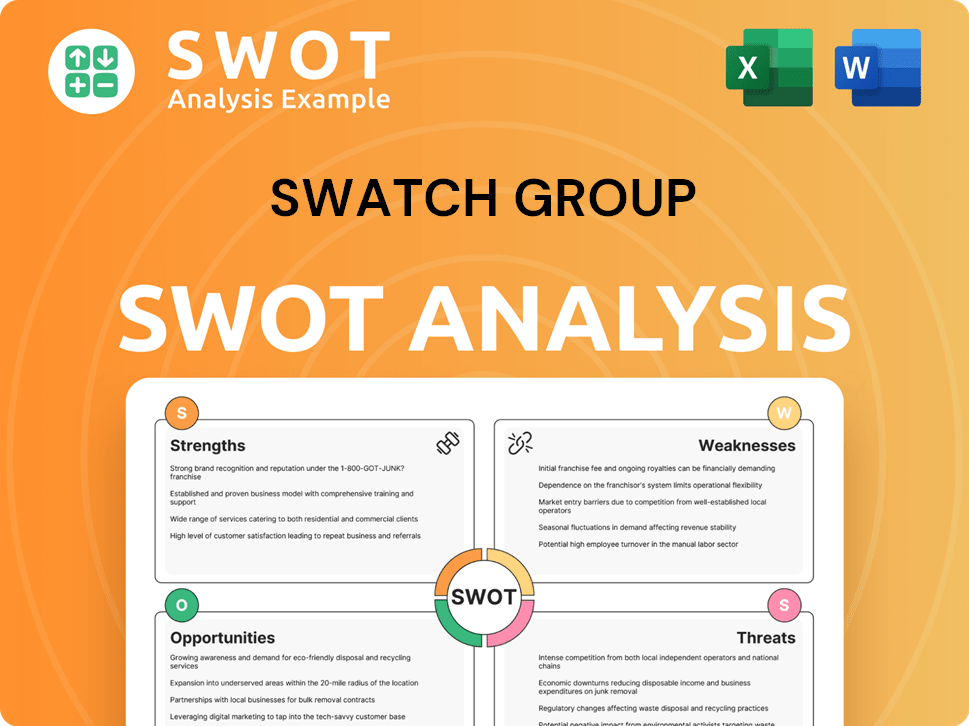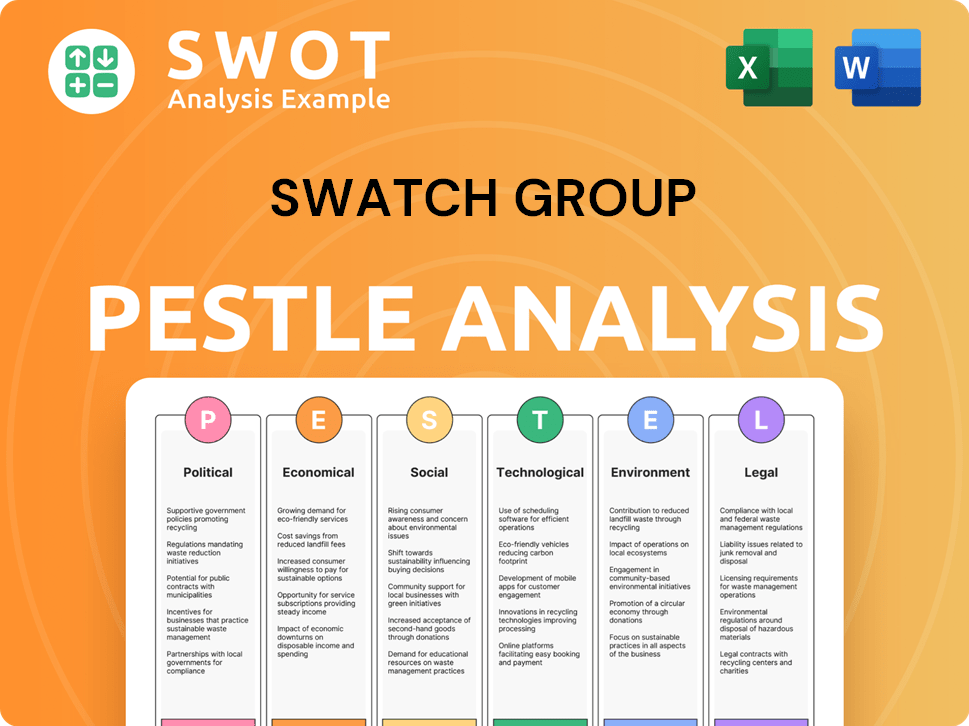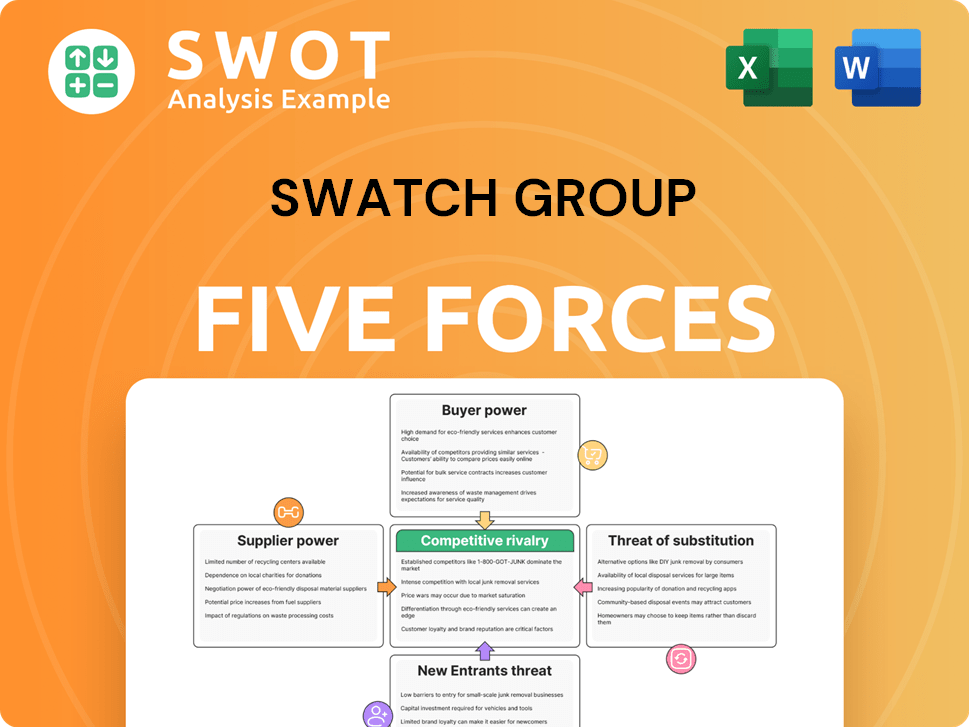Swatch Group Bundle
Unveiling Swatch Group's Guiding Principles: What Drives Their Success?
Understanding a company's core principles is key to grasping its market position and future trajectory. For Swatch Group, a titan in the watchmaking industry, its mission, vision, and core values are the bedrock of its global dominance.

This exploration delves into the Swatch Group SWOT Analysis, uncovering the essence of their Swatch Group mission, Swatch Group vision, and Swatch Group core values. Discover how these elements shape their Swatch Group strategy, influence their diverse Swatch Group brands, and build upon their rich Swatch Group history, providing insights into what drives their commitment to quality and craftsmanship.
Key Takeaways
- Swatch Group's mission, vision, and values are central to its identity and market position.
- Vertical integration and a multi-brand strategy are key implementations of their core principles.
- Innovation, quality, and emotional connection are crucial differentiating factors.
- Explicitly integrating digital transformation and sustainability could strengthen their statements.
- Adherence to these principles is vital for continued success in the evolving watch industry.
Mission: What is Swatch Group Mission Statement?
The Swatch Group's mission is to design, manufacture and sell finished watches, jewellery, watch movements and components. The Group also produces electronic systems used in watchmaking and other industries.
Let's delve deeper into the Swatch Group mission.
The Swatch Group mission statement clearly outlines its core business activities: design, manufacturing, and sales. This encompasses the entire value chain, from conception to distribution.
The mission specifies the product categories: finished watches, jewelry, watch movements, and components. This diverse portfolio allows Swatch Group to cater to various market segments.
The market scope is global, as implied by 'sell'. Swatch Group's products are available worldwide, reflecting its international presence and reach.
A unique value proposition lies in their vertical integration, encompassing both finished goods and essential components, along with electronic systems for various industries. This provides greater control over quality and supply.
This mission is primarily product and manufacturing-centric, emphasizing their capabilities across the value chain. This focus is crucial for maintaining quality and innovation.
An example reflecting this mission is their continued investment in manufacturing technologies and their role as a key supplier of movements to other watch brands. Another example is their diverse product portfolio, catering to different market segments through their various brands. For instance, the Swatch Group invested CHF 170 million in research and development in 2023, underscoring its commitment to innovation and manufacturing prowess. Further insights into the company's financial structure can be found in this article about Revenue Streams & Business Model of Swatch Group.
The Swatch Group mission statement highlights the company's dedication to the entire watchmaking process, from design to distribution. Understanding the Swatch Group vision requires looking at how this mission translates into long-term goals. The Swatch Group core values further shape how this mission is executed, influencing everything from product development to customer service. The Swatch Group strategy is deeply intertwined with its mission, driving decisions about brand portfolio, manufacturing processes, and market expansion. The diverse range of Swatch Group brands allows the company to target various consumer segments while remaining true to its core mission. The Swatch Group history reveals a consistent focus on innovation and quality, which aligns with its mission to provide high-quality timepieces and components. The company's commitment to its mission is evident in its substantial investments in manufacturing and its diverse brand portfolio, ensuring its continued success in the global market.
Swatch Group SWOT Analysis
- Complete SWOT Breakdown
- Fully Customizable
- Editable in Excel & Word
- Professional Formatting
- Investor-Ready Format

Vision: What is Swatch Group Vision Statement?
The Swatch Group's vision, though not explicitly stated as a forward-looking declaration, is implicitly one of sustained global presence and diversification: to maintain its position as a leading international company in the manufacture and sale of watches, jewelry, watch movements, components, and electronic systems.
Let's delve into the nuances of the Swatch Group's vision.
The Swatch Group vision isn't a bold proclamation of future dominance, but a reflection of its current reality. It's about maintaining and expanding its multifaceted role in the global market. This approach highlights a strategy of stability and organic growth.
The company's vision is intrinsically linked to its global presence. With a diverse portfolio of Swatch Group brands, the company caters to a wide range of consumers. This diversification helps mitigate risks and ensures resilience in fluctuating markets.
The vision emphasizes the company's core competencies: watchmaking, jewelry, and related technologies. This focus allows the Swatch Group to leverage its expertise and maintain a competitive edge. They are not trying to be everything to everyone, but rather, the best in their chosen fields.
Unlike some companies with overly ambitious visions, the Swatch Group's vision is grounded in reality. It focuses on sustainable growth within its existing areas of expertise, making it a pragmatic and achievable goal. This approach is reflected in its consistent financial performance.
While the vision is rooted in existing strengths, it also implies a commitment to adaptability and innovation. The company's involvement in electronic systems for watchmaking and other industries suggests a willingness to embrace new technologies and market trends. This is a key component of the Swatch Group strategy.
The Swatch Group's long-term vision for the future is one of sustained presence and influence. This long-term perspective is evident in its investments in research and development, as well as its commitment to quality and craftsmanship. This is a key aspect of understanding the Owners & Shareholders of Swatch Group.
The Swatch Group's vision, therefore, is not a radical departure from its current position, but a reinforcement of its established strengths and a commitment to continued global relevance. It's a vision of stability, diversification, and sustained leadership in the watchmaking and related industries. The company's financial performance in recent years, with revenues consistently in the billions of Swiss francs, demonstrates the effectiveness of this vision. For example, in 2023, the Swatch Group reported net sales of CHF 7.88 billion, showcasing its continued success in achieving its vision.
Swatch Group PESTLE Analysis
- Covers All 6 PESTLE Categories
- No Research Needed – Save Hours of Work
- Built by Experts, Trusted by Consultants
- Instant Download, Ready to Use
- 100% Editable, Fully Customizable

Values: What is Swatch Group Core Values Statement?
Understanding the core values of Swatch Group is crucial to grasping its enduring success in the competitive world of horology. These values shape the company's identity and guide its actions, influencing everything from product development to its global market presence.
Innovation is a cornerstone of the Swatch Group's strategy, driving its competitive edge. This commitment is evident in the development of groundbreaking movements like the Sistem51, which revolutionized automated watch assembly. The company continues to invest heavily in research and development (R&D), allocating approximately CHF 225 million in 2023, to ensure its brands remain at the forefront of technological advancements and design.
Quality is a non-negotiable value for Swatch Group, underpinning the reputation of its diverse portfolio of brands. This commitment to excellence is reflected in the meticulous craftsmanship of its high-end timepieces and the reliability of its more accessible models. Rigorous quality control processes are implemented throughout the manufacturing process, ensuring customer satisfaction and reinforcing the brand's legacy of precision and durability.
Swatch Group recognizes the importance of creating an emotional connection with its consumers, leveraging the unique identity of each brand within its portfolio. Through compelling marketing campaigns, immersive brand experiences, and watch designs that resonate with specific lifestyles, the company cultivates a loyal customer base. The company's ability to connect with consumers emotionally has been a key factor in its sustained success, with strong brand recognition across global markets.
Sustainability is an increasingly prominent value for Swatch Group, reflecting a growing awareness of its environmental and social responsibilities. This includes initiatives to reduce the environmental impact of manufacturing processes, ethical sourcing of materials, and designing products for longevity and repairability. The company is actively working to integrate sustainable practices throughout its operations, aligning with evolving consumer expectations and contributing to its long-term vision. For example, the company is exploring the use of bio-sourced materials in its products and packaging.
These core values of Swatch Group, from innovation to sustainability, collectively define its unique approach to the watchmaking industry. They guide the company's strategic decisions and shape its interactions with customers, employees, and the broader world. To understand how these values translate into action, explore how the Target Market of Swatch Group is influenced by these principles. Next, we will examine how the Swatch Group mission and vision influence the company's strategic decisions.
How Mission & Vision Influence Swatch Group Business?
The Swatch Group mission and Swatch Group vision are not merely aspirational statements; they are the cornerstones upon which the company builds its strategic decisions. These guiding principles shape every facet of the organization, from product development to global market expansion, ensuring a cohesive and focused approach to the competitive landscape.
Swatch Group's commitment to both finished goods and components directly supports its vertically integrated strategy. This approach allows for greater control over the supply chain and manufacturing costs, a critical advantage in the watch industry. This is evident in their continued investment in manufacturing facilities, solidifying their role as a key supplier to the industry.
- Investment in specialized manufacturing facilities ensures high-quality production.
- Control over component production reduces reliance on external suppliers, mitigating risks.
- This strategy enhances efficiency and responsiveness to market demands.
- It allows for greater flexibility in product design and innovation.
The emphasis on a wide range of products, from accessible to luxury, is a direct result of the Swatch Group mission and influences their multi-brand strategy. This strategy allows them to target diverse customer segments globally, catering to varied tastes and price points.
The focus on innovation, a key aspect of the Swatch Group core values, drives strategic decisions in product development. This is reflected in the development of new movements, materials, and technologies that set them apart. This commitment to innovation is crucial for maintaining a competitive edge.
The company's global presence, highlighted in their Swatch Group vision, underpins their market expansion strategies. They strategically focus on key growth regions, ensuring a diversified and resilient market presence. This global approach is vital for long-term growth.
The alignment of these strategic decisions with the Swatch Group mission and Swatch Group vision contributes significantly to their position as the world's largest watchmaking group. This alignment ensures all actions are cohesive and contribute to the overall goals.
Measurable success metrics, such as market share, revenue growth, and profitability, demonstrate the effectiveness of their strategy. For instance, Swatch Group's net sales in 2023 were CHF 7,888 million, showcasing their financial strength. These metrics are key indicators of their success.
These guiding principles shape day-to-day operations by influencing production processes, quality control, and sales strategies. They also inform long-term planning regarding investments, acquisitions, and brand development. This ensures consistency and a unified approach across all levels.
The Swatch Group mission and Swatch Group vision are the driving forces behind the company's strategic decisions, influencing everything from product development to global market expansion. Understanding how these principles shape the company is crucial for investors and stakeholders alike. For a deeper understanding of the competitive environment, consider exploring the Competitors Landscape of Swatch Group. Next, we will delve into Core Improvements to Company's Mission and Vision.
Swatch Group Business Model Canvas
- Complete 9-Block Business Model Canvas
- Effortlessly Communicate Your Business Strategy
- Investor-Ready BMC Format
- 100% Editable and Customizable
- Clear and Structured Layout

What Are Mission & Vision Improvements?
While the current Swatch Group mission, Swatch Group vision, and Swatch Group core values have been foundational, strategic refinements can ensure continued relevance. These adjustments are not criticisms but rather opportunities to enhance alignment with evolving market demands and future trends within the luxury watch sector.
The Swatch Group mission could benefit from a more explicit focus on digital innovation and e-commerce. This involves articulating a commitment to enhancing online customer experiences, leveraging data analytics, and integrating digital technologies across all Swatch Group brands. This would reflect a proactive approach to the increasing importance of online retail, which accounted for approximately 20% of luxury watch sales globally in 2024 and is projected to grow to 25% by 2027, according to Bain & Company.
Integrating a clear commitment to environmental and social responsibility into the Swatch Group vision is crucial. This could involve aspiring to be a leader in sustainable luxury or responsible manufacturing within the watch industry, addressing the growing consumer demand for ethical sourcing and sustainable practices. This is particularly important given the rising consumer awareness and regulatory pressures; a 2024 Deloitte study indicated that 70% of consumers are more likely to purchase from brands committed to sustainability.
Refining the Swatch Group core values to place a greater emphasis on customer experience is essential. This would involve prioritizing customer satisfaction, personalization, and building lasting relationships with consumers across all touchpoints, both online and offline. With the luxury market becoming increasingly competitive, as highlighted in the Growth Strategy of Swatch Group, a customer-centric approach can differentiate the brand and drive loyalty.
The Swatch Group's mission and vision should explicitly embrace innovation, both in traditional craftsmanship and cutting-edge technology. This includes a commitment to exploring new materials, embracing blockchain for authenticity, and integrating smart technology into watch design. This will help the company stay at the forefront of the industry, especially with the rise of smartwatches and the increasing demand for technologically advanced products, which are predicted to reach $70 billion in revenue by 2028.
How Does Swatch Group Implement Corporate Strategy?
The Swatch Group's mission, vision, and core values are not merely aspirational statements; they are actively implemented through a variety of strategic initiatives and operational practices. This implementation is crucial for translating the company's guiding principles into tangible results and ensuring long-term success in the competitive watch industry.
Swatch Group's commitment to its mission is evident in its substantial investments in manufacturing facilities and its vertically integrated business model. This approach allows for greater control over quality, innovation, and cost, aligning with the core value of craftsmanship. The company's strategy includes:
- Maintaining and expanding its extensive network of manufacturing sites across Switzerland and other regions.
- Investing in advanced technologies and processes to enhance production efficiency and precision.
- Ensuring a consistent supply of high-quality components for its diverse brand portfolio.
- Focusing on continuous improvement in manufacturing techniques to stay ahead of industry trends.
The Swatch Group's diverse brand portfolio, ranging from accessible brands like Swatch to luxury brands like Breguet, directly reflects its vision of catering to a wide range of consumers. This strategy allows the company to capture different market segments and maintain a strong global presence. The Swatch Group strategy includes:
Innovation is a cornerstone of the Swatch Group's vision. The company consistently invests in research and development to create new technologies, materials, and designs. This commitment to innovation ensures that the group remains competitive and relevant in a rapidly evolving market. The Swatch Group mission includes:
Swatch Group's global retail presence is a key element of its strategy, enabling it to reach consumers worldwide and reinforce its brand image. The company's distribution network ensures that its products are readily available and accessible to its target markets. The Swatch Group strategy includes:
Leadership plays a critical role in reinforcing the Swatch Group's mission and vision. Public pronouncements, investor presentations, and internal communications consistently emphasize the importance of quality, innovation, and global reach. This communication helps to align employees and stakeholders with the company's core values. The Swatch Group's core values are:
While formal programs solely dedicated to communicating the Swatch Group mission and vision are not widely publicized, the decentralized structure, with strong brand identities, suggests that these principles are embedded within the culture of each brand. This approach allows each brand to maintain its unique identity while still adhering to the overarching values of the group. The Swatch Group's approach includes:
- Fostering a culture of craftsmanship and quality within each brand.
- Encouraging innovation and creativity at the brand level.
- Maintaining a strong focus on customer satisfaction across all brands.
- Ensuring that each brand aligns with the overall Swatch Group strategy.
The alignment between the stated values of the Swatch Group and its actual business practices is a key indicator of its commitment to its mission and vision. Long-term investments in R&D and manufacturing, the consistent emphasis on craftsmanship, and its global retail presence all demonstrate this alignment. The Swatch Group's business strategy reflects:
- Prioritizing long-term investments over short-term gains.
- Focusing on sustainable manufacturing practices.
- Building strong relationships with suppliers and partners.
- Continuously seeking opportunities for innovation and improvement.
For a deeper dive into the marketing strategies that support these implementations, consider exploring the Marketing Strategy of Swatch Group.
Swatch Group Porter's Five Forces Analysis
- Covers All 5 Competitive Forces in Detail
- Structured for Consultants, Students, and Founders
- 100% Editable in Microsoft Word & Excel
- Instant Digital Download – Use Immediately
- Compatible with Mac & PC – Fully Unlocked

Related Blogs
- What are Mission Vision & Core Values of Swatch Group Company?
- What is Competitive Landscape of Swatch Group Company?
- What is Growth Strategy and Future Prospects of Swatch Group Company?
- How Does Swatch Group Company Work?
- What is Sales and Marketing Strategy of Swatch Group Company?
- Who Owns Swatch Group Company?
- What is Customer Demographics and Target Market of Swatch Group Company?
Disclaimer
All information, articles, and product details provided on this website are for general informational and educational purposes only. We do not claim any ownership over, nor do we intend to infringe upon, any trademarks, copyrights, logos, brand names, or other intellectual property mentioned or depicted on this site. Such intellectual property remains the property of its respective owners, and any references here are made solely for identification or informational purposes, without implying any affiliation, endorsement, or partnership.
We make no representations or warranties, express or implied, regarding the accuracy, completeness, or suitability of any content or products presented. Nothing on this website should be construed as legal, tax, investment, financial, medical, or other professional advice. In addition, no part of this site—including articles or product references—constitutes a solicitation, recommendation, endorsement, advertisement, or offer to buy or sell any securities, franchises, or other financial instruments, particularly in jurisdictions where such activity would be unlawful.
All content is of a general nature and may not address the specific circumstances of any individual or entity. It is not a substitute for professional advice or services. Any actions you take based on the information provided here are strictly at your own risk. You accept full responsibility for any decisions or outcomes arising from your use of this website and agree to release us from any liability in connection with your use of, or reliance upon, the content or products found herein.